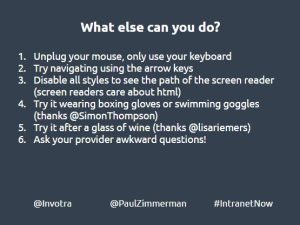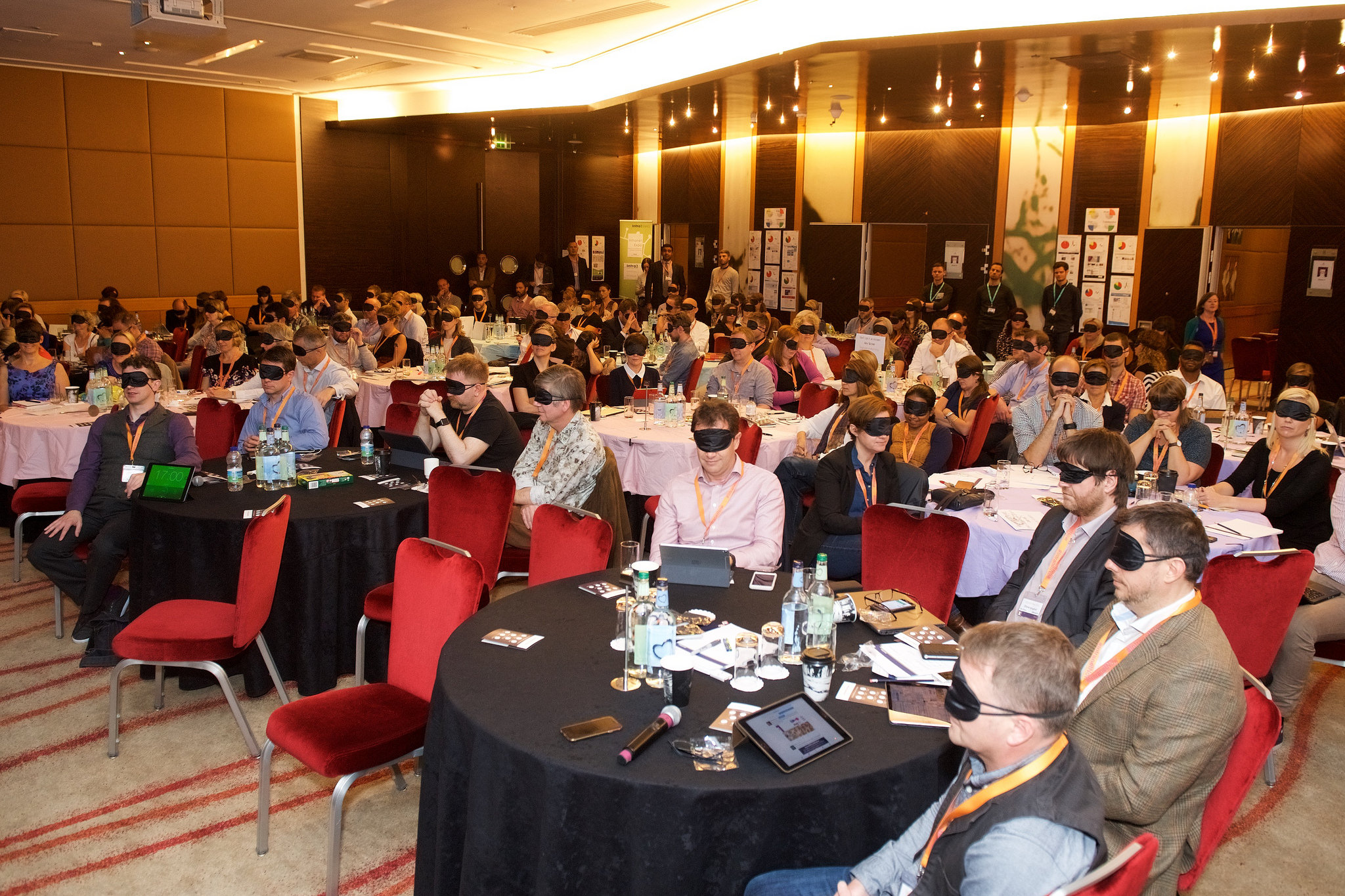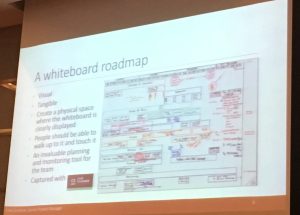Photo courtesy of Intranet Now
Two weeks after the intranet heavyweights Gerry McGovern and James Robertson headlined Interact’s Interaction conference, Wedge Black and Brian Lamb took a different approach with Intranet Now. The event zipped along with shorter-form talks between 7 and 22 minutes, and the only opportunities for questions during the afternoon World Café and workshops sessions.
Details may have been lost along the way, but big ideas and useful hints were in abundance, although I’d have liked a little more time for reflection and consolidation. I would also have valued more time in the World Café sessions rather than the too-short workshops. Those remain quibbles, Intranet Now is fantastic value for any UK-based intranet practitioner, and I’d recommend future events without reservation.
What in the business would you fix?
John Scott, of Content Formula, spun a fabulous story on the theme of “faster horses”, but shifted into practical advice on getting to know your users. This included seeking out detractors, honing detail, and John’s magic wand question “what in the business would you fix?” While I might not agree with John on everything, for example treasure hunts have been seen to work well as a way of getting people to explore an intranet, his advice to remember “you have done the research” in the face of the HiPPO is sound.
A breathtakingly short history of the intranet
Martin White combines world-weariness, cynicism, enthusiasm, knowledge and experience and is never less than interesting. Here, he rattled through a history of intranets and the digital workplace, and gave the audience pause to consider how much, or perhaps how little, has really changed.
It’s not about techniques but about mindset
Consultant James Dellow continued this theme while making the case for agile intranets, “we’re already good at building intranets” he said as he explored reasons for considering an agile approach. Evoking Willy Wonka, James told us to think like a product owner, before perhaps stretching metaphors too far with Olivia Newton John and The A-Team. He assured us that you can be agile with SharePoint, before planting an important question for all of us seeking to improve intranets “what can I give you today that will help you achieve an outcome?”
It’s all stuff you can build yourself
Keri Harrowven was the first day-to-day intranet manager to speak at Intranet Now 2016. Now at Ian Williams, a rapidly expanding housing services company, Keri explained how the intranet is an essential part of helping staff support the business. She also showed how a business process diagram in Visio could be made available in SharePoint Online – a simple solution to a profoundly complex problem.
Reluctant but fiercely competitive
Kevin Cody, achieving the treble of speaking at Intranet Now conferences, discussed Designing for engagement, and continued the theme of research. He told the valuable story how it was assumed that NHS staff needed mobile intranet access, whereas it was found to be a low priority. He then discussed the introduction of social tools and gamification to the “reluctant but fiercely competitive” sales staff at Heineken.
Using what you know’
Calum Haswell of White & Case showed how even a risk-averse law firm can deliver business value using personalisation. Combining the organisational structure and users’ experience of social media models meant that better information was put in front of the right users.
Communicating the roadmap
One of the stand-out talks of the event, despite the subject of “Intranet Governance – after the go live”. Neil Morgan of Richemont International discussed the processes behind rolling out “Maisons” for each of Richemont’s luxury brands. He explained the importance of consistency and showing how other brands are working, but this seems to me to be about thinking of the intranet as a product, and that the product roadmap is a valuable tool for keeping stakeholders interested and engaged in the process.
What was wrong with the old one?
Hanna Karppi is the Head of Digital Workplace at Skanska, conducted 100 user interviews around the world as part of the research in building the new OneSkanska intranet. In another excellent talk, Hanna shared how the resulting intranet was greeted with responses including “what was wrong with the old one? This is even worse” and “I think I will get used to it, but then you will change it.” In face, the launch went really well with high adoption levels.
The real reason staff hate your intranet
Andrew Hesselden spoke on How to Resuscitate your Intranet, showing how even small changes can lead to significant improvements. His wise advice included to draw inspiration from external trends and to show authors what good looks like.
Integration + culture + content + management
Julian Morency of sponsors Twine Intranet told the story of the business and how it developed into Software as a Service, but one that can be significantly customise. What was striking, though, was the sum “Integration + culture + content + management” which I’m sure I took out of context, but is an interesting way of considering what we all do.
What is the value of collaboration
Jenni Field discussed her time at SSP, explaining how quickly approval of the intranet turned into questions about money. She highlighted important questions of risk, especially over inappropriate use of file storage services, but also raised the value of including external stakeholders.
Please don’t call it an intranet
Alex Skinner of Pixl8’s story of building an intranet service for a global fashion house felt something of a cautionary tale, but fit a lot into 7 minutes.
The internal auditors are coming
This stark warning from Phil Mennie of PwC, I wonder, might be an opportunity as much as something to fear. From ROI to data protection (and the day’s only mention of GDPR) businesses may have to consider the effect of intranets.
Making Yammer a success
This task, faced by Kevin Austin of Shell, demonstrated how social enterprise network success can improve the bottom line. Yammer became a core strategic tool in pushing sales staff towards higher-profit premium products including the sharing of best practices as well as great stories from the front lines. Importantly, the use of videos helped change the core strategy and the creation of a network of brand influencers and ambassadors.
We needed to become the enablers
In another success story of video helping open up the business, Anne-Marie Peacock of Dialog Semiconductor, told Intranet Now of the secretive, engineer-centric culture, and they “they were the experts…we needed to become the enablers.”
The aptly named Café Dialog videos gave everyone the opportunity to learn more about people and their motivations. Anne-Marie’s approach “they were the teachers, I was the pupil” led to healthy competition between locations, and even improved CEO videos by making them much more personable.
How many words does it take to hear a page?
Sponsor Invotra has made a considerable effort to make its intranet product accessible. Paul Zimmerman, whose talk last year was one of the most forward-thinking, made a wholly different, but equally thought-provoking presentation. Accessibility is a broad subject and hard to get into, but Paul did a good job and gave us the most memorable moment of the event, where we all put on sleep masks to hear a screen reader describing a web page at high speed.

No News on the front page
The conference resumed after lunch with another engaging talk, this time from Ernst Decsey of UNICEF and how the Private Fundraising and Partnerships Intranet was rebuilt over four years.
Starting from the fine assertions that they didn’t want the old intranet on the new platform, that the IA should move from organisation to user focussed, to shift the mindset from silos to shared resources, and to prioritise content over interaction. Ernst shared some of the planning and research focussed around the theme of Lego blocks.
Many attendees will have taken three things away from this talk. First, the decision to demote news from the front page, and to replace it with campaigns and emergency content. I like this because it puts the reason for the organisation right at the heart of the intranet, in effect it massively raises the bar for front page news. Secondly, as Ernst said “reassure the audience…this is your intranet,” every page shows ownership and encourages feedback. Finally, the team has created a shopping cart so users can add any useful material as they use the intranet and can easily find again later.
Learn one task well
Andrew Gilleran shared “Why poor training is killing your intranet” and raised the subject of author training and that we’re often training our authors badly with 3 day training marathons, when short, focused training can achieve more.
Progress through communication, productivity and collaboration
Nicole Carter and Dave Hall from the Scottish Government say they’re midway through “productivity” on the journey to a fully collaborative intranet. Having worked with Gerry McGovern’s Customer Carewords, they’ve worked to build a more user and task-focused intranet. They’ve reduced the prominence of news in favour of productivity tools, and content has been cut back and simplified in order to make finding content easier.
Don’t be afraid of stepping into the unknown
Sasha de Speville of sponsors EasySharepoint started with cats, in particular the cat posters that recently replaced advertisements at Clapham Common station. Sasha picked up on the organisers’ desire to create energy and carry it into whatever might come next. Talking about why “internal communications is business critical,” and how it has a role in crossing cultures, and that the best intranet projects are led by people who are unafraid of stepping into the unknown.
Look out for interested cynics
I fear I will permanently connect Kate Cardenas with the image of a whiteboard roadmap, but it’s such a good tool for planning, thinking and communicating that I (and many others) will consider it on future projects. Kate said “you’ll never learn anything if you don’t talk to people” giving advice to “leave space for value to emerge” and “look out for interested cynics.”
Proving impact internally
Mossy O’Mahony of sponsors Newsweaver discussed some of the issues behind intranet metrics and, more importantly, understanding the business impact. In spite of the talk in business about measurement, there’s not a lot of action, especially when it comes to internal communications.
Blending everything into one is a terrible idea
Sam Marshall gave us a shorter version of his Hubs, Hives and Hangouts talk, an exploration of different working styles in the workplace and their online equivalents. Sam calls these places huddles, hives, hubs, hangouts, hermits and harbours. To illustrate that we can’t just blend these together, Sam’s analogy (and unwarranted attack) on the poor defenceless spork that will live in our memories.
I’m sorry but I am too busy to use People Finder
Diane Murgatroyd and Bettina Hasan from the Foreign & Commonwealth Office (FCO) discussed the launch and embedding of their social intranet. It started with some familiar tactics, but also some more interesting. Staff were encouraged to post photos of #myjourneytowork, leading to a collection from all over the world. Special interest tags like #chinawatchers or #uswatchers allowed those with professional or personal interests in a place to keep informed.
Later initiatives included measurement, introduction of videos, revising etiquette, and a blog called “I’m sorry but I am too busy to use People Finder” by a senior user. Diane and Bettina listed some of the things they felt worked, these included recognition of contribution, champions, storytelling, and (most interestingly) combined effort.
De-mystify what you’re doing
The final talk was by Rachel Miller and Ed Garcez highlighting lessons from working across three London councils (Westminster, Kensington and Chelsea, and Hammersmith) to build three intranets into one platform that was “consistent, but individual.” Their recipe for better relationships between CIOs and Comms was simple: put users at the heart, be visible, be approachable, and de-mystify what you’re doing.
Workshops and World Café
With the conference section at an end, we moved into a format with concurrent workshops and World Café discussions. I feel the workshops were too short to possibly be of real value, while the round-table discussions hosted by the conference speakers were potentially wonderful but unfortunately hurried. The café format is the kind of thing I want from an event like this and I would like to see it extended.
Intranet Diamonds
The day ended with thank-yous and a prize giving. James Robertson had already hauled his enormous glass trophy back to Australia, but there was a surprise second (but presumably equal) prize for the blogging team Intranetizen (Sharon O’Dea, Dana Leeson, Luke Mepham, and Jonathan Phillips). The award was thoroughly deserved, and I feel significant as three of the four remain intranet practitioners rather than consultants.
Final thoughts
As ever, Intranet Now 2016 was an exhilarating rush through a broad range of intranet subjects. The short presentation format works well, but it can feel hurried and opportunities for insight may be missed. On the other hand, the constant flow of information means there’s still a high hit rate. I don’t want to sound ungrateful to the sponsors whose contribution keeps ticket prices affordable, but some of their talks would be a lot better if they shared more of their considerable experience rather than talking up their products.
Once again, Brian and Wedge need to be commended for their efforts, and I do hope Intranet Now is financially bouyant enough for them to keep going. I am as certain as I can that I’ll be back for 2017.

